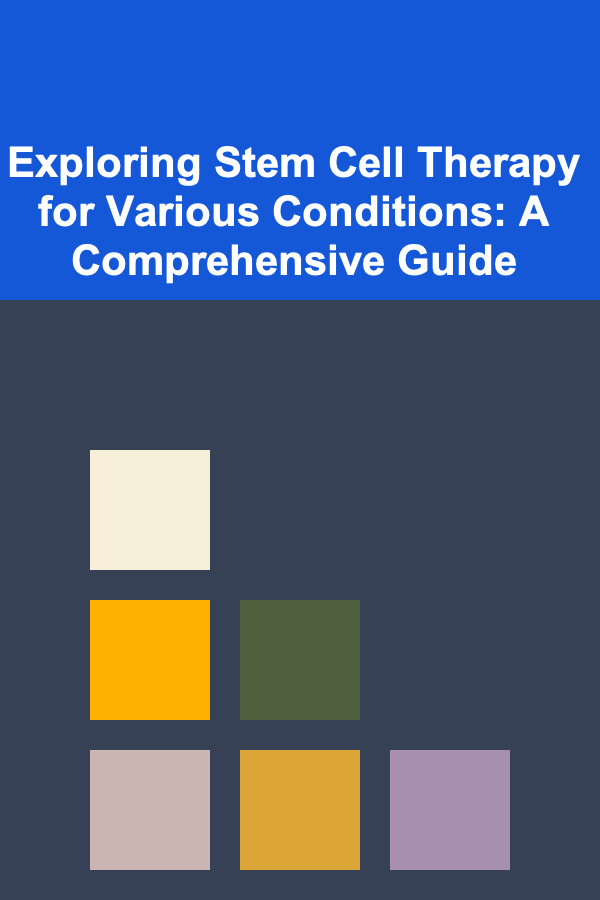
Exploring Stem Cell Therapy for Various Conditions: A Comprehensive Guide
ebook include PDF & Audio bundle (Micro Guide)
$12.99$5.99
Limited Time Offer! Order within the next:

Stem cell therapy holds immense promise for treating a wide array of conditions, from degenerative diseases to injuries and autoimmune disorders. However, navigating the landscape of stem cell treatments can be complex, requiring careful consideration of scientific evidence, regulatory oversight, ethical implications, and individual patient needs. This comprehensive guide aims to provide a deeper understanding of stem cell therapy, its potential applications, the factors to consider when exploring it as a treatment option, and the importance of informed decision-making.
Understanding Stem Cells and Their Potential
Stem cells are unique cells with the remarkable ability to self-renew and differentiate into specialized cell types. This characteristic makes them a powerful tool for regenerative medicine, with the potential to repair damaged tissues, replace lost cells, and restore function in diseased organs. There are several types of stem cells, each with distinct properties and applications:
Types of Stem Cells
- Embryonic Stem Cells (ESCs): Derived from the inner cell mass of a blastocyst (early-stage embryo), ESCs are pluripotent, meaning they can differentiate into any cell type in the body. However, their use raises ethical concerns and potential for teratoma (tumor) formation. Research using ESCs is highly regulated.
- Adult Stem Cells (ASCs): Found in various tissues throughout the body, such as bone marrow, adipose tissue (fat), and blood. ASCs are multipotent, meaning they can differentiate into a limited range of cell types specific to their tissue of origin. They are generally considered safer than ESCs due to lower risk of tumor formation and ethical considerations.
- Induced Pluripotent Stem Cells (iPSCs): Adult cells that have been reprogrammed to revert to a pluripotent state, similar to ESCs. iPSCs offer a way to obtain pluripotent stem cells without the ethical concerns associated with ESCs. They also allow for patient-specific stem cell lines, minimizing the risk of immune rejection.
- Mesenchymal Stem Cells (MSCs): A type of adult stem cell that can be isolated from various tissues, including bone marrow, adipose tissue, and umbilical cord blood. MSCs are known for their immunomodulatory properties, meaning they can modulate the immune system, making them promising for treating autoimmune diseases and inflammatory conditions.
Mechanisms of Action in Stem Cell Therapy
Stem cell therapy's effectiveness stems from several mechanisms, not just direct cell replacement:
- Cell Replacement: In some cases, transplanted stem cells can differentiate into the damaged or lost cells, directly replacing them and restoring tissue function. This is particularly relevant in conditions like Parkinson's disease, where dopaminergic neurons are lost.
- Paracrine Effects: Stem cells secrete various growth factors, cytokines, and other signaling molecules that can stimulate tissue regeneration, reduce inflammation, and promote angiogenesis (new blood vessel formation). This indirect effect is often more significant than direct cell replacement.
- Immunomodulation: MSCs, in particular, can modulate the immune system, suppressing inflammation and preventing further tissue damage. This is crucial in treating autoimmune diseases like rheumatoid arthritis and multiple sclerosis.
- Trophic Support: Stem cells can provide trophic support to damaged tissues, protecting them from further injury and promoting their survival. This is relevant in conditions like spinal cord injury and stroke.
Conditions Potentially Treatable with Stem Cell Therapy
The potential applications of stem cell therapy are vast and continue to expand as research progresses. Here are some of the conditions that are being actively investigated for stem cell therapy:
Neurological Disorders
- Parkinson's Disease: Stem cell therapy aims to replace the dopamine-producing neurons that are lost in Parkinson's disease, potentially alleviating motor symptoms. Research is ongoing, focusing on the best type of stem cell to use and the optimal method of delivery.
- Multiple Sclerosis (MS): MS is an autoimmune disease that damages the myelin sheath surrounding nerve fibers. Stem cell therapy, particularly with autologous hematopoietic stem cell transplantation (aHSCT), aims to reset the immune system and stop the progression of the disease. aHSCT has shown promising results in some patients with MS.
- Amyotrophic Lateral Sclerosis (ALS): ALS is a progressive neurodegenerative disease that affects motor neurons. Stem cell therapy is being explored as a way to protect motor neurons and slow down the progression of the disease. Clinical trials are underway to evaluate the safety and efficacy of various stem cell approaches.
- Spinal Cord Injury: Stem cell therapy aims to promote regeneration of damaged nerve tissue in the spinal cord, potentially restoring some motor and sensory function. Research is focused on using stem cells to bridge the gap in the injured spinal cord and promote axon growth.
- Stroke: Stem cell therapy aims to repair damaged brain tissue after a stroke, potentially improving neurological function. Stem cells can promote angiogenesis, neurogenesis, and synaptogenesis in the affected area.
- Alzheimer's Disease: Research is exploring the potential of stem cells to reduce inflammation, promote neurogenesis, and clear amyloid plaques in the brain, potentially slowing down the progression of Alzheimer's disease.
Cardiovascular Diseases
- Heart Failure: Stem cell therapy aims to repair damaged heart muscle after a heart attack or in patients with heart failure, potentially improving heart function. Stem cells can promote angiogenesis, reduce scar tissue formation, and differentiate into cardiomyocytes (heart muscle cells).
- Peripheral Artery Disease (PAD): Stem cell therapy aims to improve blood flow to the legs in patients with PAD, potentially preventing amputation. Stem cells can promote angiogenesis and improve the health of blood vessels.
Autoimmune Diseases
- Rheumatoid Arthritis (RA): Stem cell therapy aims to modulate the immune system and reduce inflammation in patients with RA, potentially alleviating joint pain and stiffness. MSCs are often used due to their immunomodulatory properties.
- Type 1 Diabetes: Stem cell therapy aims to replace the insulin-producing beta cells in the pancreas that are destroyed in type 1 diabetes, potentially eliminating the need for insulin injections. Research is focused on using stem cells to create functional beta cells.
- Crohn's Disease: MSCs are being investigated for their ability to reduce inflammation and promote tissue healing in the gastrointestinal tract of patients with Crohn's disease.
Orthopedic Conditions
- Osteoarthritis: Stem cell therapy aims to repair damaged cartilage in the joints of patients with osteoarthritis, potentially alleviating pain and improving mobility. MSCs are often used to stimulate cartilage regeneration.
- Bone Fractures: Stem cell therapy can accelerate bone healing in patients with fractures, particularly in cases of non-union fractures. Stem cells can promote bone formation and improve blood supply to the fracture site.
Other Conditions
- Burn Wounds: Stem cell therapy can promote skin regeneration and reduce scarring in patients with burn wounds.
- Macular Degeneration: Stem cell therapy aims to replace damaged retinal cells in patients with macular degeneration, potentially improving vision.
- Erectile Dysfunction: Stem cell therapy is being investigated as a potential treatment for erectile dysfunction, particularly in cases where other treatments have failed.
Important Note: While the potential of stem cell therapy is exciting, it's crucial to understand that many of these applications are still in the research phase. Clinical trials are ongoing to evaluate the safety and efficacy of stem cell therapy for these conditions. Stem cell therapy is not a guaranteed cure, and the results can vary from patient to patient.
Factors to Consider When Exploring Stem Cell Therapy
If you are considering stem cell therapy, it's essential to approach it with careful consideration and informed decision-making. Here are some key factors to consider:
Consult with Your Physician
The first and most important step is to consult with your primary care physician or a specialist in your condition. They can assess your overall health, evaluate whether you are a suitable candidate for stem cell therapy, and provide you with information about the potential benefits and risks.
Understand the Scientific Evidence
Thoroughly research the scientific evidence supporting the use of stem cell therapy for your specific condition. Look for peer-reviewed publications in reputable medical journals. Be wary of clinics that make unsubstantiated claims or promise miracle cures.
Research the Stem Cell Clinic
If you are considering undergoing stem cell therapy at a private clinic, carefully research the clinic's credentials, experience, and reputation. Check if the clinic is accredited by a reputable organization. Ask about the clinic's safety protocols, the type of stem cells they use, and their success rates.
Types of Stem Cells Used and Source
Understand the type of stem cells being used in the therapy (e.g., autologous, allogeneic, embryonic, adult). Autologous stem cells are derived from your own body, while allogeneic stem cells come from a donor. Knowing the source is crucial, as it can impact the risk of rejection and other complications. Make sure to ask about the method of obtaining and processing the stem cells.
Method of Delivery
Understand how the stem cells will be delivered (e.g., intravenous injection, direct injection into the affected area). The method of delivery can affect the effectiveness of the therapy and the risk of complications.
Risks and Side Effects
Be aware of the potential risks and side effects of stem cell therapy. These can include infection, bleeding, blood clots, immune rejection, and tumor formation (particularly with ESCs). Discuss these risks with your doctor and the clinic providing the therapy.
Regulatory Oversight
Understand the regulatory oversight of stem cell therapy in your country or region. The FDA in the United States, for example, has strict regulations regarding the use of stem cells. Be wary of clinics that are operating outside of these regulations.
Cost of Therapy
Stem cell therapy can be expensive, and it is often not covered by insurance. Understand the total cost of the therapy, including the cost of consultations, procedures, and follow-up care. Be wary of clinics that require upfront payment or offer financing options without providing clear information about the risks.
Ethical Considerations
Consider the ethical implications of stem cell therapy, particularly if it involves the use of embryonic stem cells. Ensure that you are comfortable with the ethical aspects of the therapy before proceeding.
Realistic Expectations
Have realistic expectations about the potential benefits of stem cell therapy. It is not a guaranteed cure, and the results can vary from patient to patient. Focus on improving your quality of life and managing your symptoms, rather than expecting a complete recovery.
Second Opinion
It's always a good idea to get a second opinion from another doctor or specialist before making a decision about stem cell therapy. This can help you make a more informed choice and ensure that you are exploring all of your treatment options.
Navigating the Legal and Ethical Landscape
The legal and ethical landscape surrounding stem cell therapy is complex and constantly evolving. It's crucial to understand the regulations and ethical considerations before pursuing treatment.
Regulatory Frameworks
Regulatory agencies, such as the FDA in the United States and the EMA in Europe, play a critical role in ensuring the safety and efficacy of stem cell therapies. These agencies have the authority to approve or disapprove stem cell products based on clinical trial data. Be wary of clinics offering treatments that have not been approved by these regulatory bodies, as they may not have undergone rigorous testing and may pose safety risks.
Unproven Therapies and "Stem Cell Tourism"
The allure of stem cell therapy has led to the proliferation of clinics offering unproven and potentially harmful treatments. "Stem cell tourism" refers to the practice of traveling to other countries to receive stem cell therapies that are not approved or regulated in your home country. These clinics often make exaggerated claims and may not adhere to proper safety protocols. It's crucial to exercise caution and avoid these clinics, as they can pose serious health risks and financial burdens.
Ethical Considerations
Ethical considerations surrounding stem cell therapy include:
- Informed Consent: Patients must be fully informed about the potential benefits, risks, and limitations of stem cell therapy before making a decision. The informed consent process should be transparent and comprehensive.
- Equity and Access: Ensuring equitable access to stem cell therapies is a significant ethical challenge. The high cost of these treatments can create disparities in access, particularly for low-income populations.
- Intellectual Property: The development of stem cell therapies raises complex intellectual property issues. Balancing the need to protect innovation with the need to ensure public access to these potentially life-saving treatments is crucial.
- Animal Welfare: Some stem cell research involves the use of animals. Ethical considerations regarding animal welfare must be carefully addressed.
Future Directions in Stem Cell Therapy
The field of stem cell therapy is rapidly advancing, with ongoing research exploring new applications, improving existing treatments, and addressing the challenges associated with stem cell transplantation. Some key areas of future development include:
Improved Stem Cell Differentiation
Researchers are working to develop more efficient and precise methods for directing stem cell differentiation into specific cell types. This would allow for the generation of large numbers of functional cells for transplantation.
Gene Editing and Stem Cell Engineering
Gene editing technologies, such as CRISPR-Cas9, are being used to modify stem cells to enhance their therapeutic properties. For example, gene editing can be used to correct genetic defects, improve stem cell survival, or enhance their ability to target specific tissues.
3D Bioprinting
3D bioprinting is a promising technology that allows for the creation of functional tissues and organs using stem cells and biomaterials. This technology could revolutionize regenerative medicine by providing a way to create personalized replacement tissues and organs for patients with organ failure.
Exosomes and Extracellular Vesicles
Exosomes and extracellular vesicles are small vesicles secreted by stem cells that contain growth factors, cytokines, and other signaling molecules. These vesicles can be used to deliver therapeutic molecules to damaged tissues, offering a cell-free approach to stem cell therapy.
Combination Therapies
Combining stem cell therapy with other treatments, such as gene therapy, immunotherapy, and rehabilitation, may enhance the effectiveness of stem cell transplantation. This approach could address multiple aspects of the disease process and promote synergistic effects.
Conclusion
Stem cell therapy holds tremendous potential for treating a wide range of diseases and injuries. However, it is crucial to approach this field with caution, informed decision-making, and realistic expectations. Consult with your physician, thoroughly research the scientific evidence, choose reputable clinics, understand the risks and benefits, and be aware of the regulatory and ethical considerations. As research continues to advance, stem cell therapy promises to play an increasingly important role in regenerative medicine, offering hope for patients with previously untreatable conditions.
Disclaimer: This information is intended for educational purposes only and should not be considered medical advice. Always consult with a qualified healthcare professional before making any decisions about your health or treatment.

How to Craft DIY Wreaths to Celebrate the Holiday Season
Read More
How to Negotiate Bills and Services for Better Rates
Read More
How to Stage a Home with Pets in Mind for Potential Buyers
Read More
How to Use Stackable Storage for Maximizing Space
Read More
The Ultimate Guide to Lowering Motorcycle Insurance Premiums
Read More
Discovering the Ancient History of Rome: A Comprehensive Guide
Read MoreOther Products

How to Craft DIY Wreaths to Celebrate the Holiday Season
Read More
How to Negotiate Bills and Services for Better Rates
Read More
How to Stage a Home with Pets in Mind for Potential Buyers
Read More
How to Use Stackable Storage for Maximizing Space
Read More
The Ultimate Guide to Lowering Motorcycle Insurance Premiums
Read More